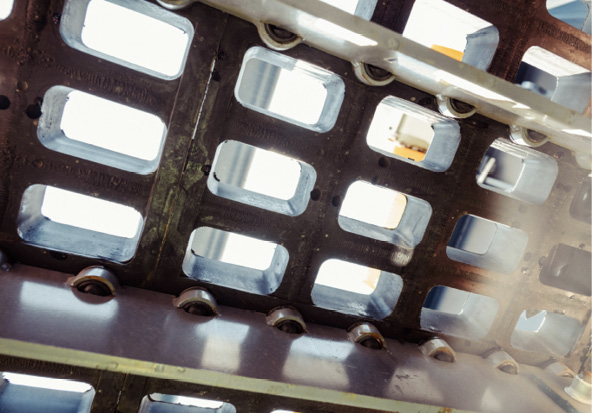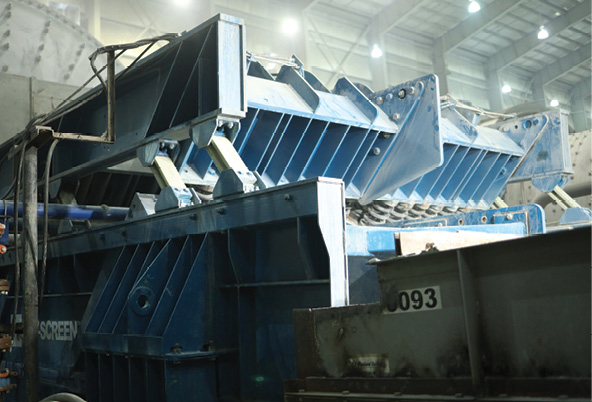North American Mining dives into the world of vibratory screens with the help of experts from Haver & Boecker Niagara, General Kinematics, McLanahan, Polydeck, and TerraSource Global.
by Jonathan Rowland

Vibrating screens “should be used when large volumes of material need to be efficiently screened, dewatered, or classified,” Todd Furrow, director of mineral sales at TerraSource Global, told North American Mining, kicking off the conversation.
“Up to four different material grades can be processed on a single vibratory screen, capitalizing on the plant’s area and infrastructure and reducing energy consumption. Vibrating screens are also advantageous when fine materials need to be processed or when materials are moist, outperforming static screens in these applications. They can also operate continuously, negating the need for frequent interventions and production stops, and they are highly customizable to the particular production requirements and constraints.”
Selecting the right screen
Many factors affect screen selection, most obviously the application – dewatering, desliming, or sizing – in which the screen will be used. “The application will also dictate the screen’s motion, which could be orbital, rectilinear, or elliptical,” continued Furrow. “The screen should also be fit for duty,” added McLanahan Vice President of Business Development for North America Mark Krause. “Lighter duty units will fit ‘easier’ applications; more severe and continuous operations will need a heavier-duty unit to deliver the performance and durability required.”
Other factors mentioned by our experts include:
- Particle size distribution (PSD or gradation).
- Particle shape, such as cubicle or slab. Irregular shapes will “complicate efficient sizing and should be considered when specifying the screen and size,” noted Furrow.
- Required throughput.
- Bulk density of the material being processed.
- Carrying capacity of the screen (especially for dewatering screens).
- Desired efficiency. “Efficiency relates directly to screen media selection, but is also application specific,” Furrow explained. “Not all operations require maximum efficiency.”
- Sufficient open area to allow for free draining of water.
- Distance between the decks. “How the deck is designed and
how easy it is to change are key to allowing safe and efficient maintenance,” added Krause.
Another consideration is a screen’s inclination angle. Inclining a screen accelerates the material flow over the screening media. “The travel rate must be fast enough to handle the volume, especially at the feed end of the top deck, but slow enough to provide time for the material to stratify first and separate second,” said Krause. Inclining the screen is “advantageous when throughput is a priority but negatively affects efficiency as the particles have less residence time on the screen, which affords less opportunity to pass through the media openings,” agreed Furrow.

Putting the vibration in vibratory screening
Of course, how the screen vibrates is another crucial consideration. Various terms are used to describe this movement:
- Amplitude: The furthest point from a particle’s starting position reached during one vibration cycle. The amplitude is half the stroke.
- Frequency and speed: Frequency is the number of vibration cycles per second as measured in hertz (Hz). Speed
describes the screen’s rotational speed (measured in rotations per minute) and is a function of the motor/drive speed and the sheaves. Speed directly impacts frequency. - Stroke (or throw): The total distance a particle moves during one vibration cycle. The counterweight placement on the shaft controls the stroke.
“Speed and stroke create material acceleration,” explained McLanahan’s Krause. “Excessive speed might reduce bearing life and place additional stress on the structure. Periodic testing of the screen speed should be taken to ensure the screen stays running at its designed speed.
Too long or great a stroke and the material will move too far and miss much of the screen area. Too short, and the material will plug the screen openings. To measure a screen’s stroke, the operator should use a stroke card in all four of the screen’s corners.”
Krause continued: “Changing speed has a more significant impact on the G-force delivered than changing the amplitude/stroke. Operations should understand what speed range the screen is designed for and how easy it is to change speeds. For example, can the bearing size support the change in G-force?”
“Amplitude and frequency are inversely proportional,” TerraSource Global’s Furrow added. “For sizing applications, a slower speed and higher amplitude are desired. This contrasts with a dewatering screen, where a lower amplitude and higher frequency are better. Plainly put, a high-frequency screen is an inefficient sizer.”
Considering screen media
Regarding the screen media, the cut point is an obvious factor but is “relatively easy to determine,” said Alex Caruana, national manager, Canadian Aggregates, Polydeck. Nonetheless, it is “often where media selection is overly focused. When the cut size has been determined, the selection should balance wear and throughput.”
“Wear often pushes operators to more durable screen media, such as polyurethane or rubber,” added Duncan High, Haver & Boecker Niagara’s processing equipment technology manager. “When switching, consider whether you have enough surface area to achieve optimum separation of materials. Sometimes, you only need to change the feed end sections on the top deck to combat high wear.” Other screen media options include “higher open-area media or self-cleaning media to help better separate materials. Material temperature also influences your screen media choice; higher-temperature materials will soften or melt rubber or polyurethane screen media.”
“Additionally, any known challenges, such as the likelihood of pegging and blinding, should be considered, as there are easy ways to address these challenges,” noted Caruana. “These may be caused by mechanical issues (inadequate amplitude/stroke, direction of throw), in which case the solution should begin there. However, material characteristics can also cause issues – and here the screen media can provide the solution.”
“Common causes of pegging and blinding include an elongated material shape or middle moisture in the product, causing the material to stick to the screen media and cake openings, reducing availability and leading to poor material separation,” added High. Some possible solutions: using rubber or polyurethane with additives to provide a nonstick surface, or using more flexible screen media, such as self-cleaning screens, slotted openings, and thinner rubber.
Screen media selections “involves making compromises,” High concluded. “For example, you may switch to a polyurethane or rubber screen media to achieve higher wear resistance and fewer changeouts; however, this may sacrifice efficiency, resulting in a high percentage of undersize in the oversize.”
Coal considerations
According to TerraSource Global’s Furrow, there are some additional factors when screening coal, including tons per hour (tph), gallons per minute (gpm) of slurry/water, and the material’s corrosive or abrasive factor. “Allowing a proper bed depth in the screen’s sizing and design is also imperative as this contributes to the screen’s efficiency.”
When choosing screen media for coal processing, “you should consider the screen’s tph, the type and size of coal you are working with, and picking the right media aperture and pattern to help separate the coal,” said Tyler Shannon, area manager – Energy and Industrial at Polydeck. “You also want to choose quality materials like rubber, steel, or urethane that can handle wear and impact. If coal has a lot of moisture, it can reduce its calorific value and increase transportation costs, so having screens and media that help dewatering is valuable.”
“An effective way to help vibratory screen media handle high moisture content is choosing media material that does not clog easily, such as rubber, steel, or urethane,” added Shannon’s Polydeck colleague Tim Brannon. “Bigger or slotted aperture holes help water drain out, and high vibrations help shake off coal particles. Changing the angle of the screen helps remove moisture more easily. Using spray bars or dewatering screens before the main screen can also remove extra water and allow the coal to separate better.”
Maintaining vibrating screens
“A proactive maintenance program, with regular equipment inspections, is critical to keep all processing equipment running efficiently and regularly,” said McLanahan’s Mark Krause. “Screens do not require much attention, but that does not mean it can be avoided. Check simple things like springs for elasticity and any breakage; sheaves, belts, and screen media for proper tension; and that openings are clean and still accurate. Most of that inspection is handled while the machine is idle; however, the four-corner stroke check must be done safely while the screen operates.” Haver & Boecker Niagara’s Duncan High also recommended “looking for and replacing worn-out openings, broken screen media, or misshapen openings.”
“Follow OEM-recommended service intervals for oil changes, v-belt tension, spring health, and inspection intervals,” added TerraSource Global’s Todd Furrow. “Vibrating screens also shake considerably during start-up and shutdown, so it is imperative that during these cycles the screen has no external impediment to its movement, which could damage structural integrity and cause unnecessary failures. Observed defects should be noted and addressed at the next maintenance opportunity.”
“Instead of relying on manual screen monitoring, many operations are moving toward sensors and computerized systems to check the operation and efficiency of their screens in real-time,” noted Krause. “These systems recognize wear early, enabling you to plan a proper shutdown and repair.
“You can also check the effectiveness of different screen settings to pick the optimal one for the current situation and need. It creates the critical logbook that is sometimes forgotten by site help. As conditions, expectations, or feed changes, the system can alert the site and suggest the necessary enhancements.”
Technology is adding more arrows to the quiver when dealing with vibrating screens, agreed Furrow. “Ancillaries such as contactless belt scales and condition monitoring systems can be added to a facilities’ SCADA interface, enhancing existing process controls. Many of these systems can be utilized from anywhere in the world. They can even be programmed to initiate a stop sequence when the vibrating screen is in danger of catastrophic failure.”
Not your standard vibratory screen: Two-Mass technology
The industry-standard vibratory screen operates by “brute force vibration or (single mass) where the driving force is attached directly to the same body that carries or transports the material,” said Derek KerKera, General Kinematics’ technical director for Mining. “Our Two-Mass technology is very different in that the body carrying the material is one mass and the drive force is attached to a second mass. These two masses are separated by several springs. During operation, the system develops a natural frequency between the spring and the two weights (masses).”

As Kerkera explained, the machine’s running RPM must be below this natural frequency by a set speed. “Adding material to a two-mass machine shifts the frequency towards the running speed, increasing the amplitude and causing the peak-to-peak stroke displacement to grow. We can control this growth via a variable frequency drive (VFD). In contrast, a brute-force machine’s stroke decreases with material loading. This means Two-Mass technology can handle 30-40% more throughput in the same footprint than a brute force machine. It also eliminates the issues other screens see with rough start-ups and shutdowns.”
“Because Two-Mass machines operate around a sub-resonate natural frequency, it takes very little drive force to start and especially maintain the machine’s vibration,” added KerKera. “Roughly one-third to one-seventh the horsepower is required to operate a two-mass machine than a brute-force machine for the same capacity. Also, because the machine needs less energy to operate and stop, the Two-Mass machine will typically last much longer without structural failures.”
